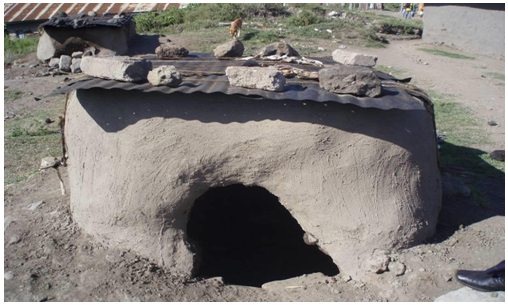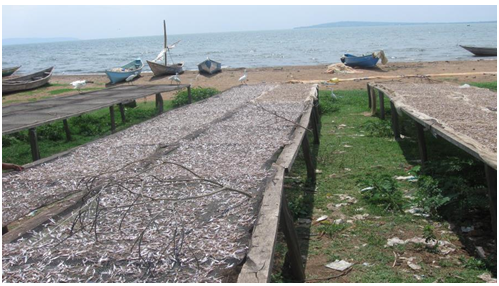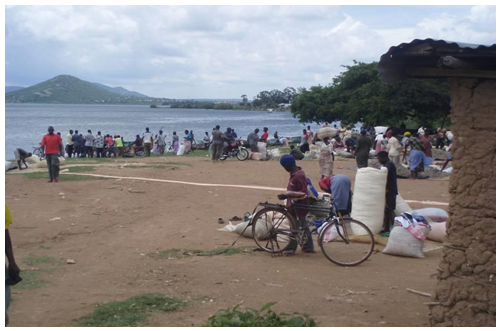-
Paper Information
- Paper Submission
-
Journal Information
- About This Journal
- Editorial Board
- Current Issue
- Archive
- Author Guidelines
- Contact Us
International Journal of Food Science and Nutrition Engineering
p-ISSN: 2166-5168 e-ISSN: 2166-5192
2017; 7(5): 111-118
doi:10.5923/j.food.20170705.02

Evaluation of Fish Processing and Preservation Systems along the Shores of Lake Victoria towards Enhancement of Sun Drying Technology
Onyango D. M. 1, Sifuna A. W. 2, Otuya P. 3, Owigar R. 1, Kowenje C. 1, Lung'ayia H.B.O. 2, Oduor A. O. 1
1Maseno University, Department of Zoology, P. O. Box 333-40105, Maseno, Kenya
2Masinde Muliro University of Science and Technology, Department of Biological Sciences, P. O. Box 190-50100, Kakamega, Kenya
3St. Paul’s University, Department of Development Studies, P. O. Box Private Bag, 00217, Limuru, Kenya
Correspondence to: Onyango D. M. , Maseno University, Department of Zoology, P. O. Box 333-40105, Maseno, Kenya.
| Email: |  |
Copyright © 2017 Scientific & Academic Publishing. All Rights Reserved.
This work is licensed under the Creative Commons Attribution International License (CC BY).
http://creativecommons.org/licenses/by/4.0/

Fish products play an important role in human diet due to peculiar lipid composition. In Kenya Lake Victoria is an important source of fresh water fish contributing over 90% of the national fish production. The Lake Victoria fisheries support both the valuable artisanal and commercial fishery. This study aimed at identifying and documenting existing fish processing and preservation technologies practiced along Lake Victoria, Kenya and their adaptability in order to improve food security. Data documented in this study was gathered through open questionnaires, focus group discussions and stakeholders meetings. Demographically it reported that women accounted for over 85% of the fisherfolk of which over 70% had basic level of education. Technologically, sun-drying of fish is the most preferred fish processing method at the landing sites. However, over 97% of the sun-drying operations are done directly on the ground or on top of old fishing nets. The study observed that for new technologies to be utilized by the fisher’s three important factors may play an important role in technology uptake by the fisherfolk, namely ease of technology to be utilized, the effectiveness of the technology and the cost of producing and maintenance of that new technology.
Keywords: Fish Processing, Fish preservation, Fish products, Lake Victoria
Cite this paper: Onyango D. M. , Sifuna A. W. , Otuya P. , Owigar R. , Kowenje C. , Lung'ayia H.B.O. , Oduor A. O. , Evaluation of Fish Processing and Preservation Systems along the Shores of Lake Victoria towards Enhancement of Sun Drying Technology, International Journal of Food Science and Nutrition Engineering, Vol. 7 No. 5, 2017, pp. 111-118. doi: 10.5923/j.food.20170705.02.
1. Introduction
- Fish from both natural sources and aquaculture are an important source of highly nutritive food, source of employment and of economic benefit. Fish products are important in human diet because of their digestibility and high nutritional value, mostly characterized by the presence of high quality proteins (contributes about 60% of the world’s supply of protein while 60% of the developing countries derive 30% of their annual protein from fish [1], rich in amino-acids methionine and lysine. Fish and seafoods play an important role in human diet due also to their peculiar lipid composition, quite different from that of terrestrial animals. Fish lipids are rich in long chain polyunsaturated fatty acids belonging to the n-3 series, particularly eicosapentaenoic acid (EPA) and docosahexaenoic acid (DHA), important constituents of cell membranes and essential in human brain and retina development. In humans, n-3 poly unsaturated fatty acids (PUFA) undergo metabolic reactions to form biologically active molecules known as eicosanoids (prostaglandins, thromboxanes and leukotrienes), that play vital roles in platelet aggregation, vasoconstriction and blood pressure regulation. Mineral elements like selenium, iodine (in marine species), phosphorus, calcium, sodium, potassium and magnesium and zinc are present in significant amounts in many fish species. Fatty fish store vitamins A and E in muscle tissue, while low-fat fish accumulate fat-soluble vitamins in the liver [2, 3]. In Kenya, Lake Victoria is an important source of fresh water fish and contributes over 90% of the national total fish production both for local and export markets. The lake is known to support valuable artisanal and commercial fishery [4, 5]. The major commercial fish species include exotic Nile perch (Lates niloticus L.), native cyprinid (Rasneobola argentea (Pellegrin), and introduced Nile tilapia (Oreochromis niloticus L.) [5, 6]. Lake Victoria is also a source of employment, food and income to riparian communities [4, 7]. Thus, fish remains the main source of protein and livelihood for the people living around Lake Victoria, Kenya.Along Lake Victoria, fish is eaten freshly cooked, preserved and or processed, and therefore many technologies aimed at processing and or preserving the fish to avoid spoilages caused by pathogens do exist. Pathogens that are common inhabitants’ of the natural aquatic environment may enter the final product via contamination routes such as; processing equipment and surfaces, food handlers and the water used in the processing plant [8]. However, these routes of contamination have not been adequately documented and in this regard, factors that influence the choice of the various preservation methods is not adequately understood. Thus, to consideration of these factors may open opportunities for improvement on the existing technologies or development of new ones. Generally, fish is prone to quality deterioration immediately after harvest resulting in economic losses. Fish spoilage occurs mainly as a result of bacterial metabolism of the fish muscle producing metabolites that decrease the quality of fish. The most common spoilage reaction is the production of biogenic amino of which trimethylamine is the most important [9, 10]. Studies have established that spoilt fish may have indigenous bacteria like Clostridium botulinum, Vibrio spp., Aeromonas hydrophila and enteric bacteria such as Salmonella spp, Shigella spp, Escherichia coli, as those which could cause food borne illness in human [11] as well and Staphylococcus aureus. For this reason, this study therefore set to identify existing processing and preservation technologies practiced along Lake Victoria, Kenya and their adaptability in order to improve food security.
2. Materials and Methods
- The study was carried out within western Kenya (Lake Victoria Basin). This study sampled 45 sites comprising of 25 fish landing sites and 18 fish farming ponds/sites. Site selection was done randomly based on the percentage of fishermen per country as at 2004 where Busia had 8.1%, Siaya (29.7%), Kisumu (8.8%), Homa bay (41.6%) and Migori (11.4%); as well as fish production, Busia (9.5%), Siaya (18.6%), Kisumu (8.9%), Homa bay (51.7%), Migori (11.3%) [12].Activities undertaken were carried out in two phases. Phase I involved holding stakeholders meetings, whereas phase II included field studies through holding focus group discussions (FDGs) and administering of open ended questionnaires. Stakeholders meeting were used to brainstorm and gather insights on the characteristics of the landing bays and fish ponds, existing fish species, fish processing and preservation methods, uptake of fisheries technologies and perception and causes of post- harvest losses. Participants for the stakeholder meeting were drawn from the government departments, private sector, NGOs and local communities engaged in fishing, transportation of fish, processing and preservation of fish and fish traders in western Kenya.Focus group discussions were conducted to different categories of stakeholders at each study site to get more insights on the existing fish species, processing and preservation methods. The categories included fishermen, different fish processors, traders and transporters. Structured open ended questionnaires were then administered to at least 30 randomly selected; fish processors, traders and transporters to validate information from the FGDs on the existing fish processing and preservation methods. In-depth interviews were conducted to at least one identified key informant from each category of existing fish processing and preservation methods at each site.Observations were made and photography taken of the existing fish processing and preservation methods at each site.
3. Results and Discussion
|
|
|
 | Figure 1. A picture of a traditional smoking kiln (Chorkor oven) |
 | Figure 2. Sun drying of Dagaa (R. argentea) on old fishing nets placed on the ground |
 | Figure 3. Sun drying of Dagaa on raised racks |
 | Figure 4. Fisherfolk collecting Dagaa after drying and packing them in gunny bags for transport to the market or storage |
|
|
4. Conclusions
- Based on our findings, since over 70% of the fisherfolk have basic level of education, simple and les complex fish processing technologies should be offered to them. Women account for over 85% along Lake Victoria, Kenya, and generally play numerous roles in the fishery which may also influence uptake of any new technology offered. However, for the technologies to be utilized by the fisherfolk three important factors were identified to influence uptake; these include ease of technology to be utilized, its effectiveness for instance if it prolongs shelf-life of the product and have low cost of production and maintenance.Dagaa (omena) and Nile perch are the two major fish types processed within Lake Victoria, Kenya and that sun-drying is the most commonly used technology. Although direct drying on the ground or on top of old fishing nets accounts for over 97%, the technologies do not guarantee the safety of the product and are also less effective as they are contaminated with soil and dust and therefore responsible for high levels of post harvest losses due to quality deterioration. Therefore a technology that aims to change this scenario may have a high impact on fish post harvest loss along Lake Victoria, Kenya but should also be easy to use and affordable to the fisherfolk.The study also shows that the fisherfolk along the shores of Lake Victoria in most cases make their own fish storage arrangements. Although there are Beach Management Units (BMUs) present in all the fish landing sites. Over 80% of the fisherfolk require storage facilities demonstrating a need for such facilities. Having designated storage facilities may also improve the quality and safety of the fish products, by offering pest control and minimizing contamination. Storage facilities at the landing sites are mainly required for sun-dried dagaa and smoked fish products.The authors acknowledge Maseno University management and the Department of Zoology for offering facilities to enable the study be carried out; the Beach Management Units (BMUs) and various District Fisheries Officers along Lake Victoria and all stakeholders participated in the study in one way or another. Funds for this study were provided by NACOSTI (NCST/STI/5/003/374).
 Abstract
Abstract Reference
Reference Full-Text PDF
Full-Text PDF Full-text HTML
Full-text HTML



